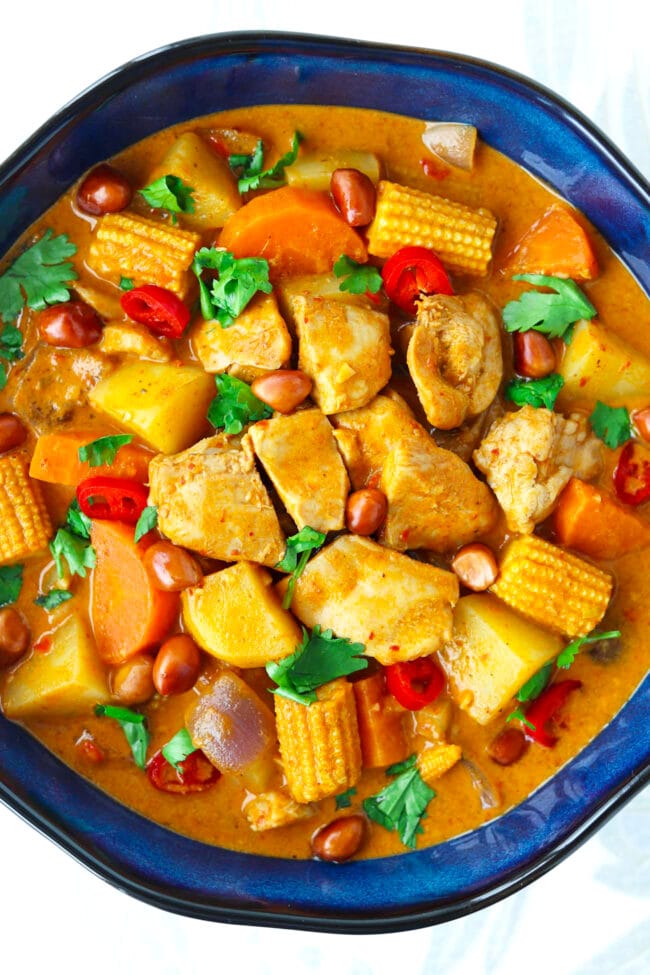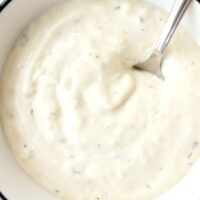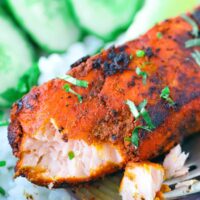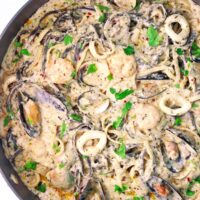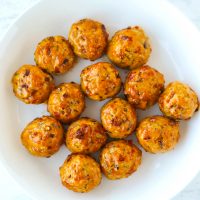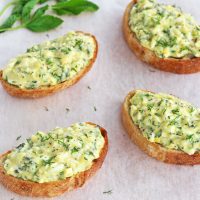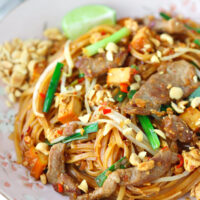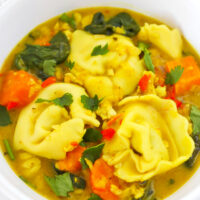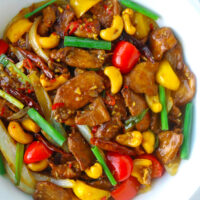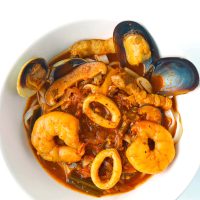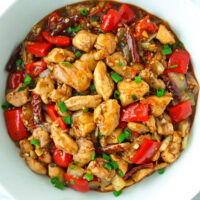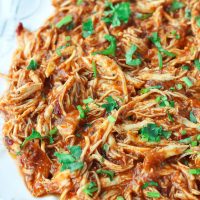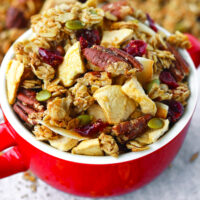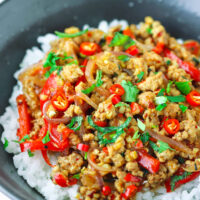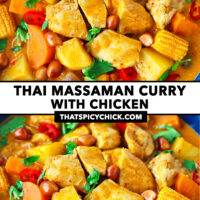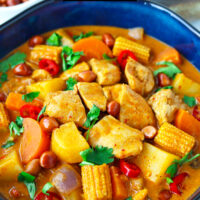Thai Massaman Chicken Curry
This post contains affiliate links.
This Thai Massaman Chicken Curry is a rich and fragrant coconut milk based curry with tender chicken, onion, potatoes, carrots, baby corn, and peanuts. It’s easy to make in one pot in 45 minutes with a store-bought curry paste, full of the BEST warming and fragrant spices, and so delicious with steamed rice!
Thai Massaman Chicken Curry is a delicious and creamy curry that’s full of cozy and warming flavors!
Tender chicken pieces, aromatic massaman curry paste, carrots, potatoes, baby corn, and peanuts are simmered in a velvety and dreamy coconut milk based curry.
Thanks to using a store-bought Thai brand of massaman curry paste, this curry can be ready in just 45 minutes on any given weeknight! It’s also a one-pot curry so there’s less cleanup post cooking, and there’s minimal active cooking time as the curry cooks itself during simmering.
Massaman curry is typically not very spicy. It has a savory-sweet flavor profile with warming spices thanks to Malay and Indian influences. However, my version of this curry has a spicy kick to it with the addition of fresh chilies and Thai chili powder. Feel free to leave them out or use less to suit your heat preference.
Serve this flavorful curry with steamed Thai jasmine rice and I’m sure you’ll love it!
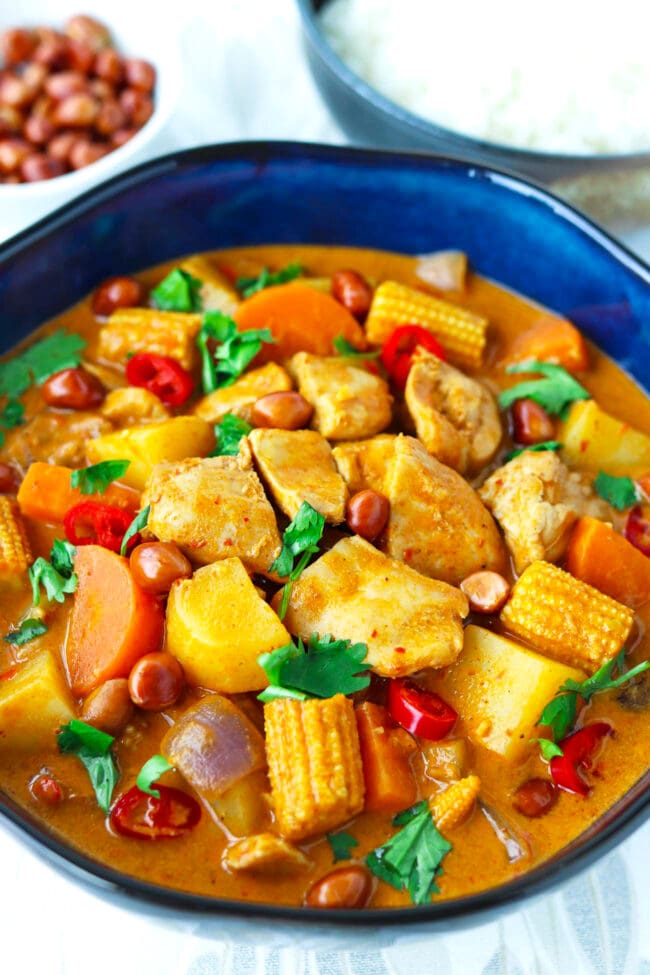
Why This Recipe Works
- Quick and easy to make! All you need is one pot or wok and it’s ready in just 45 minutes!
- Bursting with exotic and warming flavors! Massaman chicken curry is unique in that it has both the exotic herbs you find in Thai curries like galangal and lemongrass and also warming spices that are found in Indian curries like cardamom, cinnamon, cumin and nutmeg.
- Store-bought curry paste saves time. Using a good quality Thai brand massaman curry paste ensures that this curry boasts authentic flavors but requires less time than if you were to make the curry paste from scratch.
- Customizable spice level. You can customize the spice level easily by adding more or less curry paste and fresh chilies.
- Super cozy and comforting! A bowl of this curry with rice on a chilly fall or winter day is guaranteed to warm up your insides!
Ingredient Notes and Substitutes
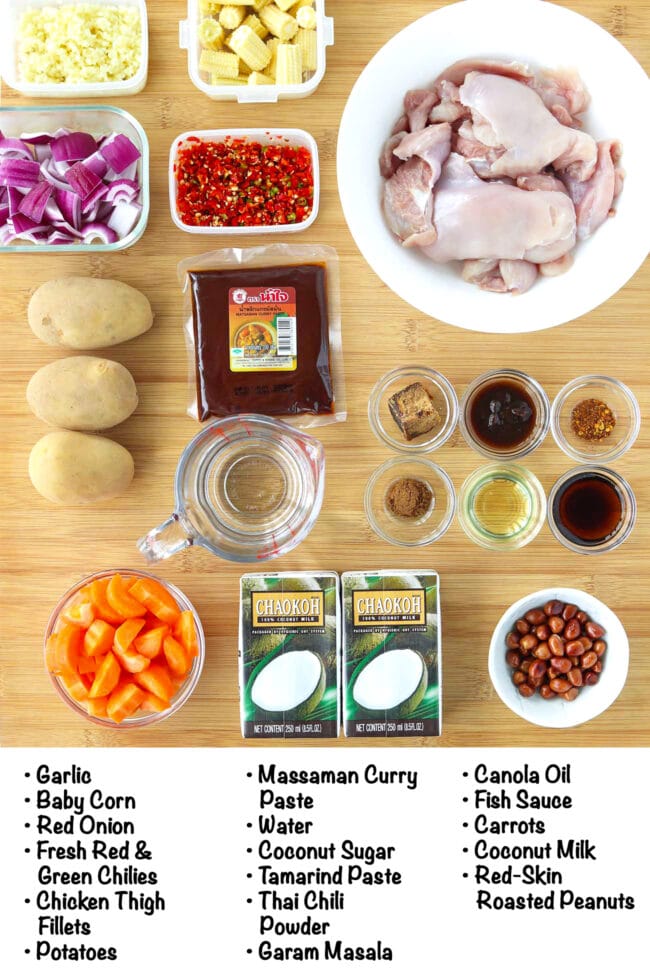
- Chicken Thigh Fillets: I’ve used boneless and skinless chicken thigh fillets that I’ve cut into bite-sized pieces. I don’t recommend using chicken breasts for this curry as it may become too tough and dry during simmering.
- Red Onion: Or you can use yellow or white onion, or Asian red shallots that have been cut into wedges.
- Fresh Red & Green Chilies: Although Massaman curry is not typically very spicy, I’ve used Thai Bird’s Eye red chilies and Thai prik kee nu green chilies for an extra kick! You can use any small hot red and green chilies you like. Adjust the quantity to taste based on your heat level preference. Or leave them out for a milder and more traditional curry. The prik kee nu green chilies are listed as optional as they may be difficult to find outside of Asia. If you do find them, use with caution. They may be tiny in size but are fiery HOT!
- Potatoes: I used Japanese potatoes, but Yukon Gold or any other waxy potatoes will work well. You can even swap for sweet potatoes if you like. Avoid using Russets as they’ll take more time to become tender.
- Coconut Sugar: Massaman curry is sweeter than other Thai curries and the sugar is needed to balance out the warm spices and flavors in the curry paste. I used a Malaysian coconut sugar which is known as ‘gula kelapa’. Similar to Thai palm sugar, it comes in the form of form of hardened discs. You’ll need to shave it finely with a knife so that it dissolves more easily into the broth. You’re welcome to swap for palm sugar or use granulated light brown or white sugar.
- Canola Oil: Or use any neutral flavored cooking oil.
- Massaman Curry Paste: Massaman (also called Matsaman or Mussaman) curry paste is milder than most other Thai curry pastes such as red and green curry paste. It’s made with dried red chilies, shallots, garlic, lemongrass, galangal, makrut lime peel and/or bay leaf, shrimp paste, salt and warming spices such as cumin, cardamom, nutmeg, and cinnamon. I used a store-bought one to save time. I highly recommend using a massaman curry paste that’s produced by a Thai brand. Namjai (what I’ve used), Mae Ploy, and Maesri are excellent choices and will make the curry taste more authentic. Find it in a well-stocked supermarket or purchase it online.
- Coconut Milk (unsweetened): Use full-fat coconut milk for the best creamy texture.
- Garam Masala: Since massaman curry has spices that are typically used in an Indian curry, I added a generous pinch of my homemade garam masala – which is made from cumin, cardamom, cloves, cassia bark/cinnamon – to boost the flavor. While you can use store-bought garam masala in a pinch, homemade versions taste so much better and fresher! Plus, it’ll last for months in your pantry and can be used in a variety of Indian recipes and also some of my Middle Eastern recipes!
- Tamarind Paste: Massaman curry has a hint of tangy sweet flavor which comes from tamarind paste (also known as tamarind concentrate or puree). It’s a light brown paste/sauce made from fresh tamarind and used in dishes like pad thai, pad mee korat, and Thai cashew chicken. Some brands produce more sour paste than others, so you might need to adjust the amount to taste. Be sure to use a Thai tamarind paste and not an Indian one. The latter is sticky and black and not the one preferred for this curry. Find a jar in Thai or Asian grocery stores, the Asian aisle of large supermarkets that are well-stocked with international ingredients, or purchase it online.
- Fish Sauce: Substitute with light soy sauce in a pinch.
- Thai Chili Powder: This is optional and you can add it if you’d like an extra kick of heat. Leave it out for a milder curry.
- Roasted Red-Skin Peanuts (unsalted): Peanuts are a key ingredient and they set this curry apart from other Thai curries. They add an extra layer of texture and a slight nutty flavor. You can use dry roasted peanuts if you can’t find roasted red-skin peanuts. If you find raw red-skin peanuts, you can roast them gently in a pan with a little oil (or without) until they smell nutty and their skin has turned a deep shade of reddish brown. Feel free to add more peanuts than what I’ve specified and up to ½ cup if desired.
Full ingredient list and amounts are in the recipe card below.
How to Make Thai Massaman Chicken Curry
1. Sauté the onion and aromatics. In a little oil over medium-high heat, sauté the onion and garlic until softened. Then add the fresh chilies and sauté until fragrant.
2. Sauté the veggies. The potatoes, carrots and baby corn until slightly softened.
3. Add the massaman curry paste. Stir-fry the paste until it starts to breaks down.
4. Add the chicken. Continue to stir-fry until the chicken is mostly no longer pink.
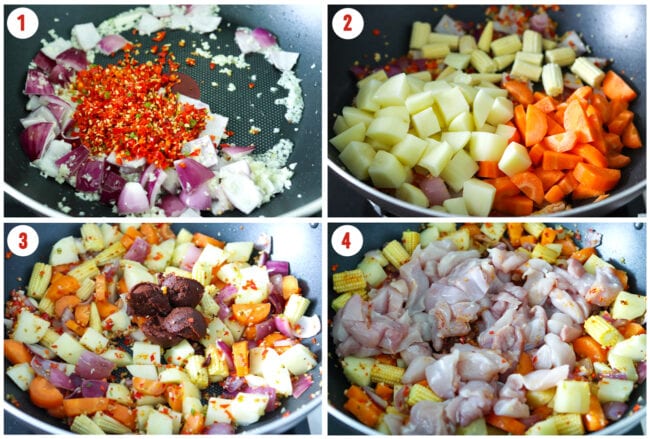
5. Build the curry. Pour in the coconut milk and water. Stir until the curry paste has fully broken down. Then stir in the coconut sugar, garam masala, tamarind paste, fish sauce and Thai chili powder (if using). Reduce the heat and cover. Simmer until the potatoes and carrots are tender. (You can check for doneness by piercing both with a fork.)
6. Stir in half of the roasted peanuts. Switch off the heat.
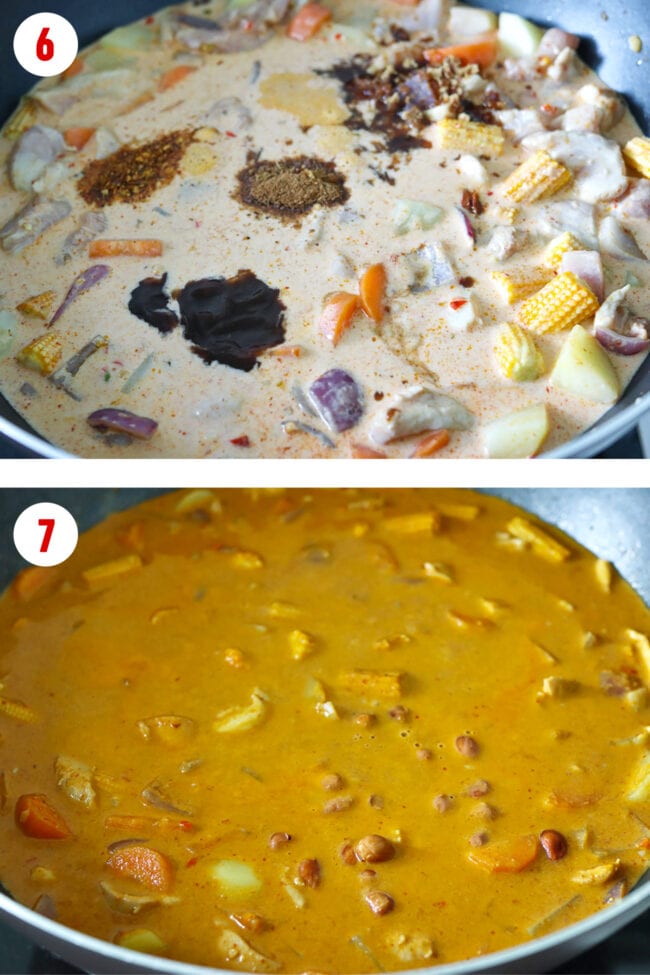
Serve! Transfer to a serving bowl or dish. Garnish with chopped coriander, the remainder roasted peanuts, and finely sliced mild large red chili. Enjoy with warm steamed rice!
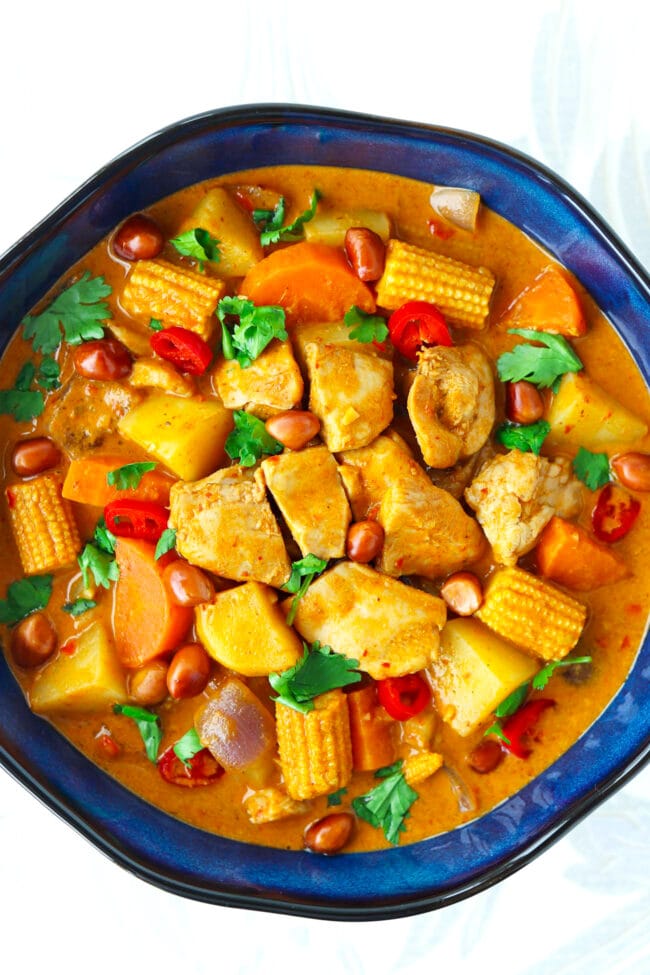
Full detailed instructions are in the recipe card below.
Cook’s Tips
- Adjust spice level to taste. For a milder curry, start with just 2 tablespoons of massaman curry paste and stir in more later after simmering and tasting if desired. Also use less (or omit) the fresh red and green chilies and the Thai chili powder.
- Make it vegetarian/vegan. Use a plant-based protein or tofu instead of chicken and soy sauce instead of the fish sauce. Also be sure that the massaman curry paste you’re using is vegetarian and doesn’t contain shrimp paste.
- Serve with rice. Serve with Thai jasmine white rice, brown rice, or even cauliflower rice for a low-carb option.
- Store leftovers in the fridge in a sealed airtight container. It’ll stay good for up to 4 days and can be reheated in the microwave for 1-2 minutes or until hot throughout.
- Freeze leftovers. This curry freezes beautifully and will stay good in your freezer for up to 3 months. Thaw overnight in the fridge. Reheat in the microwave for smaller individual portions or on the stove in a pot for a larger quantity.
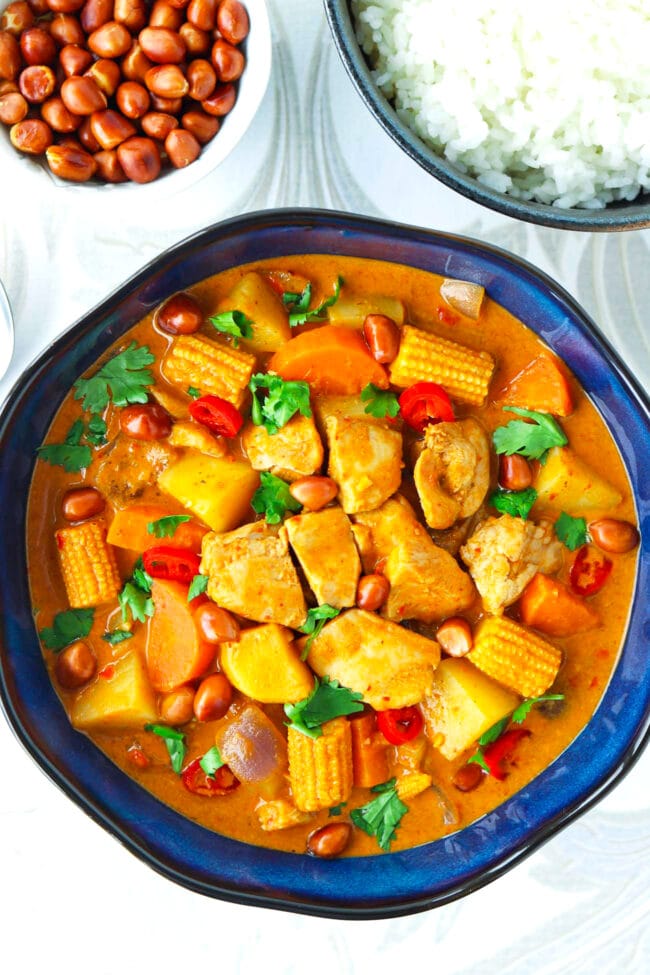
FAQs
It’s a Thai coconut milk based curry with Indian and Malay influences. It’s typically made with potatoes, red onion, massaman curry paste, tamarind, peanuts and chicken. Some variations will include other veggies like carrots and baby corn. Bay leaf and cinnamon sticks may also be added to flavor the curry.
Unlike Thai red and green curry, massaman curry is not very spicy but is rather beautifully spiced and savory-sweet in flavor. The curry paste is full of warming spices like cumin, coriander, cardamom, cinnamon and nutmeg. If you’d like to make a milder curry, use less curry paste and omit the fresh chilies and Thai chili powder. You can also add more sugar if needed.
While massaman curry is often made with beef chuck and lamb shank at restaurants, chicken can also be used for the protein. Chicken thigh fillets are preferred over chicken breasts as they will not become dry and tough during simmering.
Massaman means “Muslim” in Thai. The curry is believed to have originated in Southern Thailand, where there are a lot of Thai people with Malay/Muslim ancestry. Hence the name “Muslim curry” when directly translated.
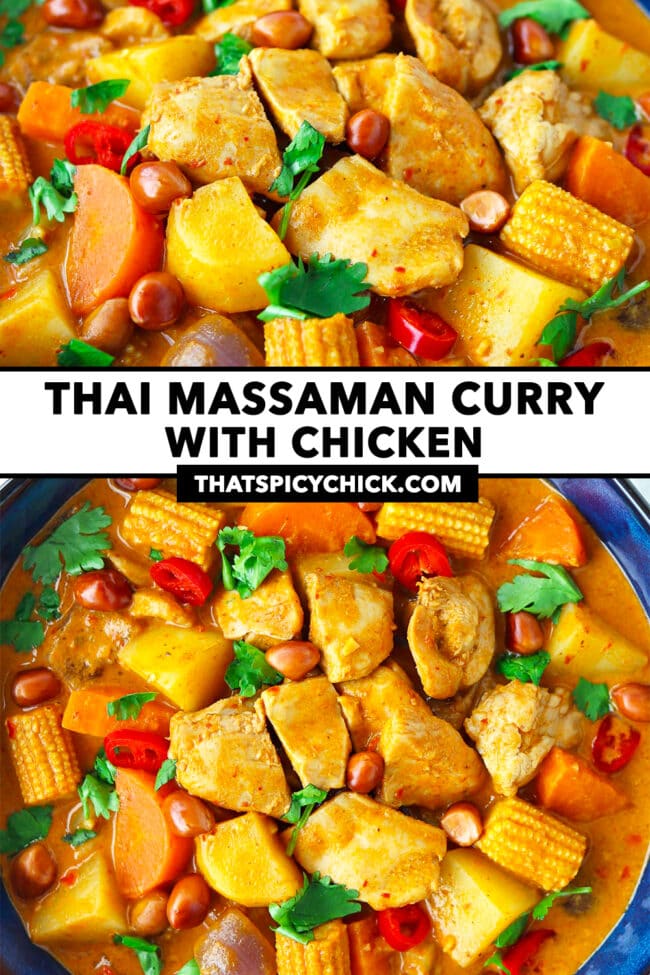
More Thai and Thai-inspired Curries
- Thai Panang Chicken Curry
- Thai Yellow Egg Curry
- Choo Chee Salmon Curry
- Easy Thai Green Chicken Curry
- Peanut Butter Chicken Curry
- Khao Soi Gai (Northern Thai Coconut Curry Noodle Soup with Chicken)
- Or browse the entire Curry & Stews recipe collection.
You May Also Like
MADE THIS RECIPE? If you make this recipe, leave a comment below and let me know how you liked it! Take a photo and tag it with @thatspicychick on Instagram and hashtag it #thatspicychick and I’ll be sure to share your masterpiece!
STAY CONNECTED! You can also follow me on Pinterest, Facebook or Instagram. Sign up for my email list to get my latest recipe in your inbox weekly!
PrintThai Massaman Chicken Curry
Loaded with tender chicken, carrots, potatoes, baby corn, and peanuts, this Thai Massaman Chicken Curry is easy to make in one pot in 45 minutes with a store-bought curry paste and full of the BEST warming and fragrant spices! Serve with steamed rice for a cozy meal.
- Prep Time: 15
- Cook Time: 30
- Total Time: 45 minutes
- Yield: 5 1x
- Category: Dinner
- Method: Simmer
- Cuisine: Thai
Ingredients
- 500 grams / 1.1 pounds Chicken Thigh Fillets, skinless – cleaned, pat-dried, excess fat trimmed, cut into bite-sized pieces
- ½ medium Red Onion (note 1) – diced
- 6 Garlic cloves – finely minced
- 2 – 14 fresh Red Chilies (optional – Thai Bird’s Eye or any small hot red chilies – note 2), to taste – finely chopped
- 2 – 6 Prik Kee Nu Green Chilies (optional – note 2), to taste – finely chopped
- 285 grams / 3 small potatoes (Yukon Gold or other waxy potatoes, or sweet potatoes) – peeled, diced
- 165 grams / 2 medium Carrots – peeled, sliced into thin ¼-cm discs, then sliced in half
- 6–7 pieces Baby Corn – cut into 1-inch pieces
- ¼ disc (12.5 grams) Coconut Sugar, to taste – shaved with a knife (note 3)
- 2 TBLS Canola Oil (or other neutral oil)
- 2 – 4 TBLS Massaman Curry Paste (note 4)
- 500 ml / 17 ounces Coconut Milk
- 118ml / ½ cup Water
- ½ TSP Garam Masala (homemade preferred, but store-bought is fine)
- 1 TBLS Tamarind Paste (note 5)
- 1 TBLS Fish Sauce, to taste
- ¼ TSP Thai Chili Powder (optional)
- 3 TBLS unsalted Roasted Red-Skin Peanuts (or dry roasted peanuts – note 6)
- To Serve: Steamed rice, chopped coriander (cilantro), finely sliced large red (mild) chili (optional)
Instructions
Prep:
- Prepare the ingredients: Clean and trim off the excess fat from the chicken thigh fillets and slice into bite-sized pieces. Chop/slice the red onion, garlic, red chilies, prik kee nu green chilies (if using), potatoes, carrots, and baby corn as indicated in the ‘Ingredients’ section. Finely shave the coconut sugar with a knife and set aside.
For the Massaman Chicken Curry:
- Sauté the onion and aromatics: Heat 2 tablespoons canola oil in a large nonstick wok (or large pot) over medium-high heat. Once hot, add the onion and garlic. Sauté for a minute until softened. Add the fresh red chilies and prik kee nu green chilies and sauté to combine for 30 seconds until fragrant.
- Add the veggies: Add the potatoes, carrots and baby corn. Sauté for 1-2 minutes until slightly softened.
- Add the curry paste and chicken. Add the Massaman curry paste and stir-fry for a minute until it starts to breaks down. Add the chicken and stir-fry for 2 minutes, until the chicken is mostly no longer pink.
- Build the curry: Pour in the coconut milk and water. Stir until the curry paste has fully broken down. Stir in the coconut sugar, garam masala, tamarind paste, fish sauce and Thai chili powder (if using). Lower the heat the medium and cover. Simmer for 20-24 minutes or until the potatoes and carrots are tender.
- Adjust seasonings: Uncover and stir. Taste and adjust seasonings by stirring in more sugar, tamarind paste and fish sauce if needed. Stir in half of the roasted peanuts and switch off the heat.
- To Serve: Transfer to a serving bowl/dish. Garnish with chopped coriander, the remainder roasted peanuts, and finely sliced large red chili (if using). Serve immediately with warm steamed rice.
Notes
- Red onion. You can use diced yellow or white onion, or 6 small Asian red shallots that have been cut into wedges instead if preferred.
- Fresh red chilies and Thai prik kee nu green chilies. Although Massaman curry is not typically very spicy, I’ve used Thai Bird’s Eye red chilies and Thai prik kee nu green chilies for an extra kick! You can use any small hot red and green chilies you like. Adjust quantity to taste based on your heat level preference. Leave them out for a milder and more traditional curry. The prik kee nu green chilies are listed as optional as they may be difficult to find outside of Asia. If you do find them, use with caution. They may be tiny in size but are fiery HOT!
- Coconut sugar. I used a Malaysian coconut sugar which is known as ‘gula kelapa’. Similar to Thai palm sugar, it comes in the form of form of hardened discs. You’ll need to shave it finely with a knife so that it dissolves more easily into the broth. You can swap for palm sugar, or granulated light brown or white sugar.
- Massaman curry paste. Massaman (also called Matsaman or Mussaman) curry paste is milder than most other Thai curry pastes. It’s made with dried red chilies, shallots, garlic, lemongrass, galangal, makrut lime peel, shrimp paste, salt and warming spices such as cardamom, nutmeg, and cinnamon. I used a store-bought one to save time. I highly recommend using a massaman curry paste that’s produced by a Thai brand. Namjai (what I’ve used), Mae Ploy, and Maesri are excellent choices and will make the curry taste more authentic.
- Find it in a well-stocked supermarket or purchase it online. For a milder curry, start with just 2 tablespoons of massaman curry paste and stir in more later after simmering and tasting if desired.
- Tamarind paste. Also known as tamarind concentrate or puree. This light brown paste/sauce made from fresh tamarind adds a hint of tangy sweet flavors to the curry. Some brands produce more sour paste than others, so you might need to adjust the amount to taste. Be sure to use a Thai tamarind paste and not an Indian one. The latter is sticky and black and not the one preferred for this curry. Find a jar in Thai or Asian grocery stores, the Asian aisle of large supermarkets that are well-stocked with international ingredients, or purchase it online.
- Roasted Red-Skin Peanuts (unsalted): Peanuts are a key ingredient and they set this curry apart from other Thai curries. They add an extra layer of texture and a slight nutty flavor. You can use dry roasted peanuts if you can’t find roasted red-skin peanuts. If you find raw red-skin peanuts, you can roast them gently in a pan with a little oil (or without) until they smell nutty and their skin has turned a deep shade of reddish brown. Feel free to add more peanuts than what I’ve specified and up to ½ cup if desired.
- Leftovers and storing. Store leftovers in a sealed airtight container in the refrigerator for up to 4 days. Reheat in the microwave for 1-2 minutes or until hot throughout. To freeze, transfer to a freezer-safe container or sealable bag and freeze for up to 3 months. Thaw overnight in the fridge. Reheat in the microwave for smaller individual portions or on the stove in a pot for a larger quantity.
Nutrition
- Serving Size: 1 serving
- Calories: 515
- Sugar: 13.1g
- Sodium: 1136.1mg
- Fat: 31.2g
- Saturated Fat: 18.2g
- Unsaturated Fat: 9.6g
- Trans Fat: 0g
- Carbohydrates: 30.7g
- Fiber: 4.8g
- Protein: 27.1g
- Cholesterol: 94mg
This post may contain affiliate links. We are a part of the Amazon Services LLC Associates Program, an affiliate advertising program designed to provide a means for us to earn a small commission (at no extra cost to you) by linking to Amazon.com and affiliated sites. The nutritional information provided is approximate and can vary based on several factors. It should only be used as a general guideline. For more information, please see our Disclosure.

